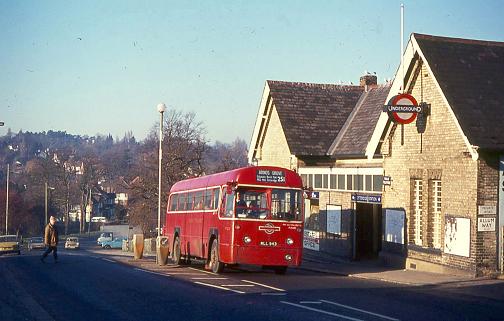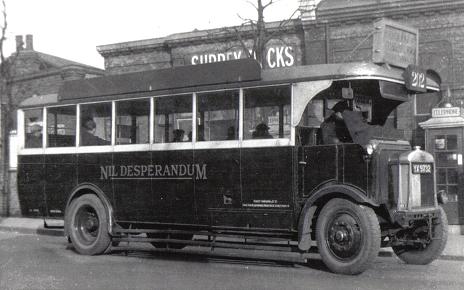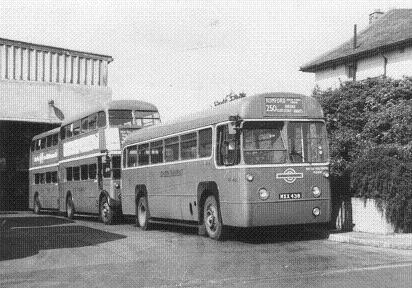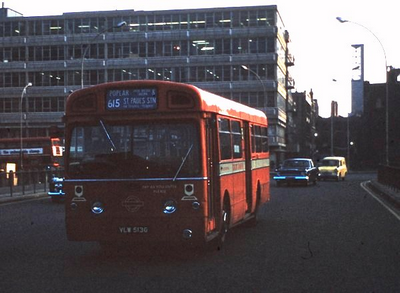London Transport route numbering
 London has had three main phases of route numbering, of
which the third allocated the 200-series numbers to single-deck
routes in 1934. If you are curious about route numbering,
read on... London has had three main phases of route numbering, of
which the third allocated the 200-series numbers to single-deck
routes in 1934. If you are curious about route numbering,
read on...
Route numbers are such an obvious and integral part of the bus
scene that it is hard to imagine a network without them.
Yet London's extensive horse bus network in the 19th Century used
colour-coded liveries to distinguish routes, and numbering only
arrived after motor-buses, in 1906.
RF525 passes Totteridge
Station on 3 Jan 77, in the last month of RF operation of the
251 across quieter parts of north
London. Note the blind display with its nearside number,
suggesting that new blinds had been produced for the BLs that were
to enter service later in the month. This was also the bus's
last month with LT, being sold to Meopham School in February.
Photo © John Parkin
In the beginning
It was Vanguard, a competitor to the London General Omnibus
Company (LGOC or 'the General'), that introduced numbers to its
routes in April of that year, to enable motor buses to be used on
more than one route. There were 12 routes by the time
Vanguard merged with the General in 1908; several of today's routes
have a direct lineage from those original Vanguard numbers,
including route 2.
The network expanded dramatically and there were over 100 routes
by 1914. The first use of a letter suffix was on the
35A in 1912, indicating an offshoot to a different
destination. Much use was made of letter suffixes throughout
the 20th century - the last was the 77A that was
renumbered 87 on 6 Jun 2006. Suffixes were to achieve a
particular importance in 1924.
The Bassom Scheme
Bus destination and route displays were controlled by
Metropolitan Police regulations from 1910. In 1924, the
London Traffic Act was introduced, primarily to control the
independent 'pirate' operators, but also imposed a numbering scheme
on London's buses. In what became known as the Bassom Scheme,
after the acting chief constable of the Met Police, the full
length of a route was allocated the main number, whilst short
workings used letter suffixes and variations were given related
numbers.
This scheme led to some bizarre consequences. The famous
route 11 from Shepherds Bush to Liverpool Street ran (up to every
1¾ minutes) for nearly 10 years as the 11E,
after the route was extended to the British Empire Exhibition at
Wembley and therefore only Wembley services could be numbered
11. The Epping variation of the 10
to Ongar changed from the 10A to the 100. Another
well known pair, which continue to share roads today, is the 59 and
its variant the 159, the latter winning everlasting fame
on 9 Dec 2005.
 Numbers 1 to 199 were reserved for General routes and
201 to 299 plus 509 to 599 for authorised independent routes.
An example is the 202, introduced by GH
Allitt and Nil Desperandum in 1929, which lasted unchanged into the
third generation of route numbers. Country routes entering
the Metropolitan Police area were allocated numbers in the 3xx
series (routes from the north) or 4xx series (routes from the
south), leading in due course to these series applying to Country
Area operations. The range 601 to 699 was introduced in 1927
for additional LGOC routes. From 1926, the LGOC acquired
independent operators and retained their routes, so the distinction
in route numbering was not maintained. Numbers 1 to 199 were reserved for General routes and
201 to 299 plus 509 to 599 for authorised independent routes.
An example is the 202, introduced by GH
Allitt and Nil Desperandum in 1929, which lasted unchanged into the
third generation of route numbers. Country routes entering
the Metropolitan Police area were allocated numbers in the 3xx
series (routes from the north) or 4xx series (routes from the
south), leading in due course to these series applying to Country
Area operations. The range 601 to 699 was introduced in 1927
for additional LGOC routes. From 1926, the LGOC acquired
independent operators and retained their routes, so the distinction
in route numbering was not maintained.
Nil Desperandum YX9732 on the 202 at Surrey
Docks Station. After acquisition by the LGOC, the Nil
Desperandum name was retained for a while but buses were fitted
with garage and running number plates.
Photo Paul Brophy collection
All through this period, bus usage was such that routes
were operated by double-deckers wherever physically possible,
except in certain cases of experimental or very rural routes.
Before the second world war, small one-man
buses operated the latter routes, whilst some with physical
restrictions were very busy and required high capacity,
crew-operated single-deckers. The differentiation was
enshrined in the numbering system in the next change, in 1934, a
decision which seems rather curious from the perspective of the
travelling public.
London
Transport
The amalgamation of the Underground Group (including the
General) with the trams (together with the acquistion of the
independent operators) on 1 Jul 33 brought into existence the
London Passenger Transport Board, who soon adopted the trading
title 'London Transport'. Unification led to the
third and final numbering system, after the police no longer had
responsibility. The revised system has undergone development
since then, but is still broadly in use today. This was
introduced on 3 Oct 34, and allocated specific blocks of numbers as
follows:
1 -
199 Central Area double-deck
routes
200 - 289 Central Area single-deck routes
290 - 299 Central
Area night routes
300 - 399 Country
Area (north) routes
400 - 499 Country
Area (south) routes
Short workings no longer took a suffix and variations were
usually identified by letter suffixes.
It is immediately obvious that some groups of routes are missing
from the list. Tram routes used their own numbers from 1
upwards, often duplicating bus route numbers. Several were
renumbered on 3 Oct 34, but still in the 1 to 99 series. An
interesting feature of the tram numbering was the propensity to use
pairs of even numbers for the same circular route running
in opposite directions - such as Embankment routes 6/8, 16/18
and 36/38. Trolleybus routes were not renumbered until
summer 1935 when they started the 6xx series (routes 1 to 5
becoming 601 to 605), and subsequently the 5xx series was
added. Following the tram format, a few routes worked loops
in pairs, such as the 513/613 round the Holborn
Circus loop.
Green Line services before the war used letters and during the
war numbers from 1 upwards; when reintroduced after the war, the
range 701 upwards was used. Over the years, additional
numbers were required for night routes, and these were allocated
backwards, reaching 284 in 1959. Meanwhile, the Country Area
had run out of numbers with the growth of new towns after the
war, and from the early 1950s new sequences were started, with
800-849 in the northern area and 850 upwards south of the
river. The latter were never as numerous and only reached
854.
 Our interest is naturally focussed on the
single-deck routes. 45 routes operated by single-deckers
were renumbered on 3 Oct 34, representing
all but about a dozen that already had
numbers in the 200 series. Among them were a series of
routes in the Romford area that had used the old 'outer area'
letter prefixes - routes G2 to G7 were renumbered in the range 247
to 252. Our interest is naturally focussed on the
single-deck routes. 45 routes operated by single-deckers
were renumbered on 3 Oct 34, representing
all but about a dozen that already had
numbers in the 200 series. Among them were a series of
routes in the Romford area that had used the old 'outer area'
letter prefixes - routes G2 to G7 were renumbered in the range 247
to 252.
Route 250 was renumbered from G7 in 1934. Here
OMO RF461 sits outside North Street garage with its driver's
emergency door open.
Photo Ian Armstrong collection
As routes were double-decked, they were initially renumbered out
of the 2xx series. The last to be thus renumbered
was Kingston's 214 which was
double-decked as the 131 on 29 Oct 41. Maybe it was felt that
renumbering was wasteful in a time of austerity? So on
25 Feb 42, when the Pinner to Uxbridge 220 was double-decked, it became the first
double-deck route in that sequence. Many more followed as new
routes opened up, but it was not until October 1965 that a
single-deck route was given a number outside the 200 series, when
the 20B was introduced.
When the trams were replaced by buses, the route numbers were
accommodated in the existing series, but this could not be achieved
for the trolleybus conversions ten years later, so in October
1960 the night routes were renumbered with N prefixes in place
of the 2, allowing (for example) trolleybus 605 to become
Routemaster route 285.
The next new sequence started with the Red Arrows in April 1966
when the first standee Red Arrow service 500 was introduced.
The two remaining Red Arrow routes still have 500-series
numbers.
_sms351_rhithe_dcwilkinson_pbrophycoll_t.jpg) The final significant introduction came as a result of
the infamous Bus Reshaping Plan, which
started in 1968 in Wood Green and Walthamstow with major upheavals
to the pattern of service and the widespread use in those areas of
'flat-fare' routes (now that all London bus journeys cost the same,
it is easy to forget that crews used to have to cope with complex
fare charts for each route). These were numbered with a
letter prefix based on the area, thus starting with the W series
and moving on to include Peckham (unless it's P for Old Kent Road -
for the conversion of the 202), Ealing
and so on. The final significant introduction came as a result of
the infamous Bus Reshaping Plan, which
started in 1968 in Wood Green and Walthamstow with major upheavals
to the pattern of service and the widespread use in those areas of
'flat-fare' routes (now that all London bus journeys cost the same,
it is easy to forget that crews used to have to cope with complex
fare charts for each route). These were numbered with a
letter prefix based on the area, thus starting with the W series
and moving on to include Peckham (unless it's P for Old Kent Road -
for the conversion of the 202), Ealing
and so on.
Parked at the Old Kent Road Canal
Bridge stand in Verney Road, Rotherhithe, SMS351's driver
reads the paper, having no conductor with whom to exchange
banter. When you have spent your working life as half a team,
working alone would have represented a significant
change. The conversion of the 202 to OMO involved a complex transition to the
P1 and P2.
Photo © DC Wilkinson, Paul Brophy
collection
Recent times
After the Country Area passed to the National Bus company, the
former standardisation began to fragment. This also meant
that the numbers 300-499 were no longer off limits to London
Transport, and from about 1990, use of former 'country' numbers
started in earnest on central routes.
Some of the more recent numbers bear shades of the Bassom
Scheme. An early example is the 412, used for
the southern section of route 12 when that route was shortened
in 1990. Another is the 329, established in 1992 to cover the
former northern part of the 29. This latter, like several
others, betrays its roots by the working over the same roads of the
night service of the old route, in this case the N29, where the
modern preference for 24-hour services is not practical.
Also widespread are letter-prefixed routes, which unlike
suffixed routes have not been outlawed. Whilst their
flat-fare origins are long gone, most but not all reflect local
networks. Special cases include the T-routes at Addington,
which complement Tramlink services, and X-routes for express
services.
Express services themselves are of
course not new. Several were operated in the 1950s and 60s,
including the 93 and 212. These used blue blinds, a practice
which was continued on the Red Arrow services. Present-day
X-prefix routes include the X68 which has operated since the 1980s
and the X26, final remains of the 726/725
from the Green Line network.
 Various interesting variants occurred in the
1970s, such as the Express Merlin route 615
between Poplar and St Pauls (its numbering derived from
the 15), a failed experiment. Poplar's MBS513 works through
the brutalist surroundings of Aldgate's Gardiner's Corner in
December 1970 (an earlier photo of Gardiner's Corner, in 1950,
is here). Various interesting variants occurred in the
1970s, such as the Express Merlin route 615
between Poplar and St Pauls (its numbering derived from
the 15), a failed experiment. Poplar's MBS513 works through
the brutalist surroundings of Aldgate's Gardiner's Corner in
December 1970 (an earlier photo of Gardiner's Corner, in 1950,
is here).
Photo © Roger
Newport
Additional sequences introduced in more recent years include the
900-series mobility services, generally operating a few journeys a
week, and 600-series school routes. And happily for those who
don't like too much uniformity, there are all sorts of exceptions -
the 607 express version of the 207, the 805, a privately-registered
route for workers at Heathrow now adopted by TfL and renumbered
435, the PR2 for Park Royal and the RV1 Riverside tourist
route. But no suffix letters, as these would confuse the
travelling public.
|